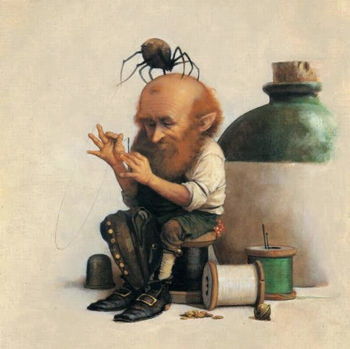Tue 29 Mar 2016
Helpful fairies: handle with care
Posted by PJ under fairies, folklore, hauntings, help, household spirits, spirits, tricksters, work
No Comments

There’s always one in every crowd. You know, you’ve got a good thing going and that one guy or gal pushes things too far and ruins it for everyone. This is no less true when dealing with fairies.
I was reading R. Macdonald Robertson’s Selected Highland Folktales and he told the story of “The Fairies of Pennygown.†If any of the townsfolk of Pennygown needed help with a task, they brought the work of an evening to a certain nearby sithean, a lovely green fairy hill. By morning, the task would be nicely completed: spinning, weaving, repair, mending, you name it. One villager, though, kept leaving more and more difficult things, pushing it.
One night he left by their hillock a piece of driftwood which he had picked up on the sea-shore, with instructions that it was to be made into a ship’s mast. When the villagers came next morning to collect the property left overnight, they found none of the tasks executed. This last request had angered the fairies so much that they had left their hillock, in disgust, for good.
Any reasonable being would be put out by such oafish behavior, it’s true. But it’s also true that helpful fairies are a tricky lot. They can have goodwill towards humans, but it can also turn on a dime. If they’re insulted, they can get mischievous and mean. Some say poltergeists are fairies who’ve become insulted by a householder and take it out in spite.
They also have sometimes exacting standards of what constitutes insult. Brownies and hobs, for instance, will gladly help out with the housework, usually at night like the Pennygown folk. However, they don’t want to be seen, and don’t want payment, or even expressions of gratitude. They will, though, accept gifts, mostly in the form of food, especially porridge and honey. If a householder starts taking them for granted, openly thanks them, or considers the food “paymentâ€â€”or if they try to get a glimpse of them—the brownies will forthwith abandon the house, never to be seen again or lend their help.
There are other European versions of such beings: tomte in Scandanavia, domovoi in Slavic countries, Heinzelmännchen in Germany, Haltija in Finland, many others. Some have even made the trip over the Atlantic to the Americas. But in my (admittedly limited) investigation of helpful fairy folk, I’ve only found one non-European example of work-helpful fairies, the koro-pok-guru of the Ainu people of the Northern Japanese islands.
These beings would hunt and fish for the Ainu in exchange for little gifts, leaving the goods overnight. Like the brownies, they hated being seen. Of course, one Ainu loser couldn’t leave well enough alone and blew the gig for everyone. The young man in question waited by the place where the gifts were left, determined to see a koro-pok-guru, and laid hands on the first one to appear. It was a beautiful koro-pok-guru maiden, but she and her people were so angered at this affrontery that they disappeared, never to help the Ainu or be seen again.
Very strong parallels with the European myths, but that isn’t entirely surprising. Ainu are racially distinct from the Japanese. Recent research suggests Okhotsk origins and there is still a small population of Ainu in Russia. They share that pan-European ancestry, so they share those ancient pan-European stories.
But as I said, I haven’t found anything else like it around the world. Good and bad spirits aplenty, but none who will pitch in to do the work for humans in exchange for small gifts. I am far from an expert on this, so if anyone knows of such a tradition in a non-European context, I would love to hear about it.
No Responses to “ Helpful fairies: handle with care ”